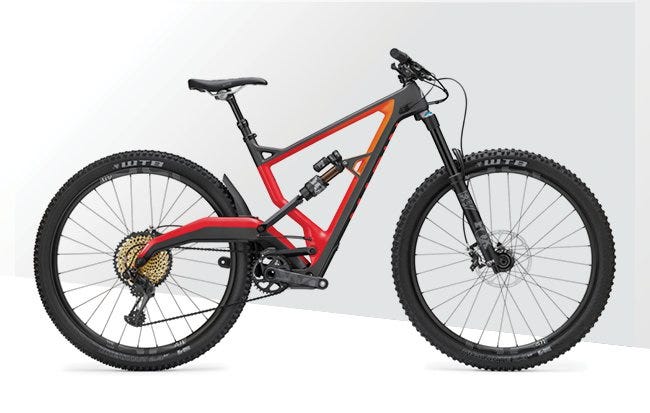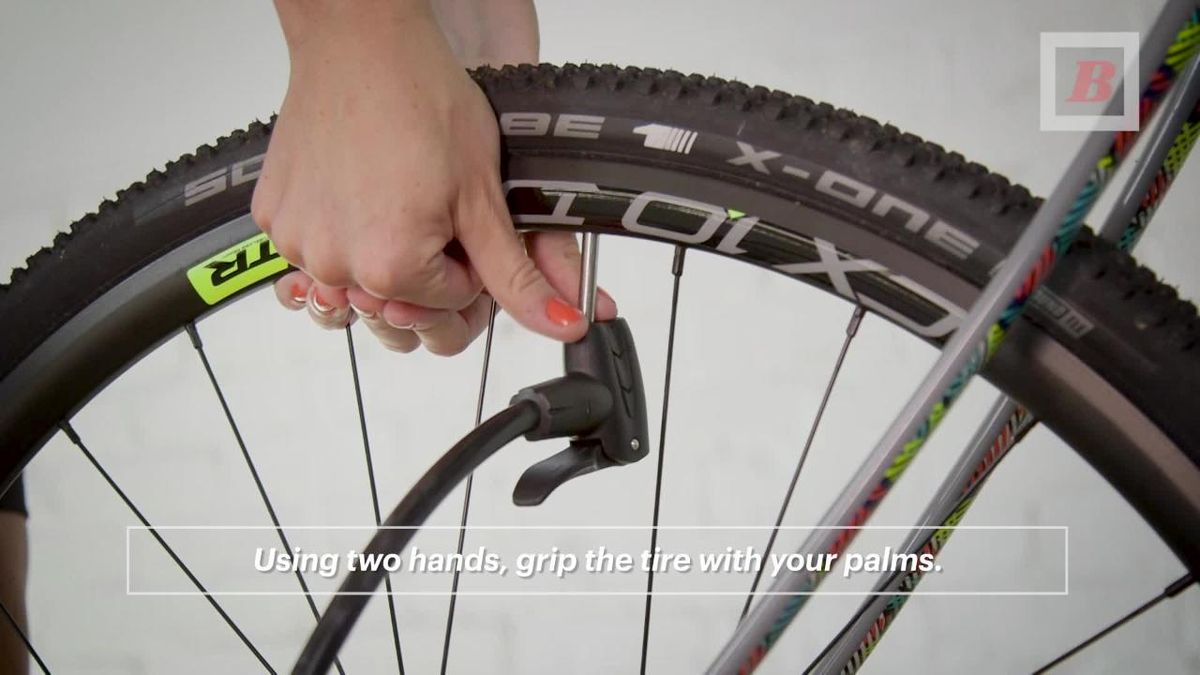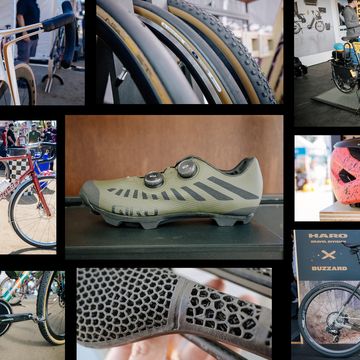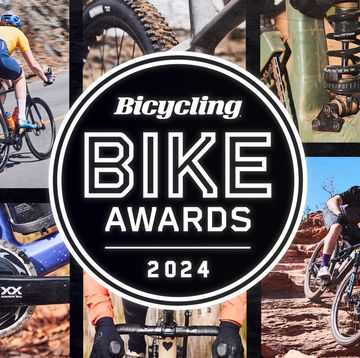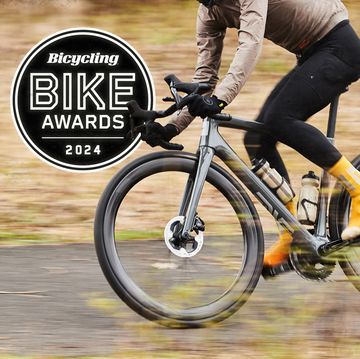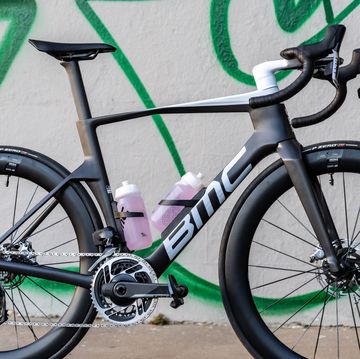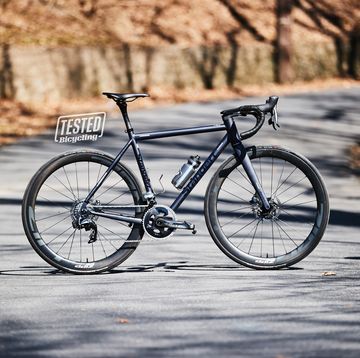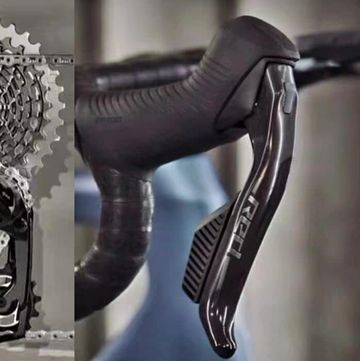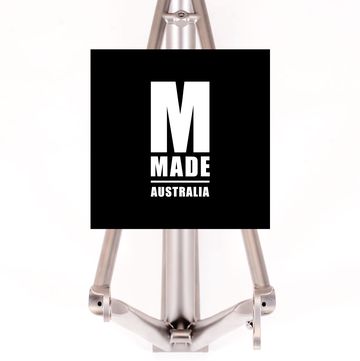Factor O2 Disc Aero Road Bike
The O2 Disc is essentially the bike that team AG2R La Mondiale piloted through the Tour de France—but equipped with disc brakes. Decked out with Dura-Ace Di2, the bike is noticeably light and features subtle aerodynamic touches: slightly dropped chainstays, a longer trailing edge on the fork, and a flattened handlebar. (Celebrate the Tour all year long with the Yellow Jersey T-shirt from our Eddy Merckx collection!)
The tubeless-compatible carbon rims come with 28mm-wide tires, and the generous width contributes to an addictively smooth ride. I found myself taking more careless lines over broken pavement and gravel. While such stable bikes often feel sedate, the O2 willingly snapped into sprints. On climbs I was able to power away from my riding buddies without even standing to pedal.
One minor inconvenience: Both wheels have bolt-on thru-axles, which require tools to detach. That said, the added stiffness makes for smooth, consistent braking in all conditions.
Riding the O2, I found myself channeling my inner Romain Bardet, and feeling a little of the composure he and his AG2R teammates always seem to project, no matter the terrain. This is the sort of bike that lets you relish every mile, and will deliver you to the finish line, be it a summit sprint or your driveway, with a few watts to spare. —Lydia Tanner
Factor O2 Disc Aero Road Bike, $11099.00, Competitive Cyclist (frame only)
At a Glance
- Disc-equipped version of AG2R La Mondiale team bike
- Dura-Ace Di2 components
- Tubeless-compatible rims; 28mm tires
- Front and rear thru-axles
Adidas Protean Sunglasses
The brand-new Proteans are an excellent pair of casual shades with some solid performance perks. When I’m riding my townie to the post office, they look classy with my khakis, but they feel like high-tech eyewear. The slightly curved lens keeps more dirt and light out than typical casual glasses. On a long road ride, my vision stayed sharp even as I descended between patches of shadow and light, and I didn’t notice any weird reflections or gaps in coverage.
Snappy hinges pop the arms into place and contribute to a stable feel on my face. Subtly textured temple grips and adjustable nose pads help keep the frames secure, although they did slide around a little on sweatier endeavors. With seven color options and prescription-lens compatibility, these are great sunnies for any urban adventure. —Riley Missel
RELATED: The 8 Worst Things You Can Do to Your Eyes
Adidas Protean Sunglasses, $99.00, Adidas
At a Glance
- Textured temple grips
- Adjustable nose pads
- 7 color options
- Compatible with prescription lenses
CamelBak K.U.D.U. Protector 10 Hydration Pack
CamelBak was the first to add spine protection to hydration packs with its K.U.D.U. (Kinetic Ultimate Damping Unit) pack three years ago. Now, it’s introducing some intriguing new features. The biggest update is the zippered attachment between the cargo area and the back protector that lets you wear the latter on its own—great for a day in the bike park, shuttle runs, or anytime you don’t need to carry much. A pair of elastic back pockets and two more on the waist belt offer some storage, even when you’re not using the cargo pack. The back protector is CE level 2 certified, meaning it’s suitable for motorcycle use, too, and can withstand multiple impacts.
The K.U.D.U. is offered in 10-liter and 20-liter capacities—as well as S/M and L/XL sizes based on torso length. I tested the 10-liter model in the smaller size; in the future, I’d size up (for reference, I’m 6-foot-0, with a short torso for my height). Despite the added bulk of the protector and its 301 grams of weight, the pack is surprisingly comfortable and stable, thanks in part to the extra-wide waist belt. With its tool roll, integrated rain cover, 3-liter reservoir, and 7 liters of storage, the K.U.D.U. Protector 10 is an excellent choice for rowdy days in big mountains. —Ron Koch
CamelBak K.U.D.U. Protector 10 Hydration Pack, $200.00
At a Glance
- Zip-off, CE level 2-certified back protector
- 10- and 20-liter capacities
- Sizes S/M and L/XL
- 3-liter reservoir; 7 liters of storage
Canyon Ultimate WMN CF SLX Disc 9.0 Team CSR Women's Road Bike
Finally! After much anticipation, Canyons are available in the US. And the German company unveiled its first models with women’s geometries. Compared with the original, the Ultimate WMN has slightly reduced reach and taller stack, which Canyon says puts women in the same race-oriented position as male riders would be on the unisex frame. It’s also lighter, more aerodynamic (saving 2 watts at 45kph, says Canyon), and the two smallest sizes sport 650b wheels. Canyon says this allows the smaller bikes to have similar geometries—and thus handling—as larger sizes.
RELATED: 8 Awesome Women’s Road Bikes for 2017
As a ride, the Ultimate WMN pulses with energy. It’s light, smooth, and jumps at every acceleration. Once moving, it has a subtle, slippery aero feel. Handling is responsive but predictable, inspiring you to move with assurance through a churning pack. The position is long and low, but still comfortable for less hard-charging rides. When you’re winding up for a sprint, the bike is solid and provides a sense of direct power transfer. On rough descents, it sticks to the road well. Reynolds Assault LE carbon rims help to plump up the 25mm tires (the frame fits up to 30mm of rubber).
One of Canyon’s strengths is a direct-to-consumer model that enables competitive pricing. For $7,000 you get SRAM eTap, carbon wheels, and disc brakes. Booyah. Lower-end builds start at $2,999. See what everyone’s so excited about now? —Gloria Liu
Canyon Ultimate WMN CF SLX 9.0 Team CSR, $6999.00
At a Glance
- Frame sizes: XXS, XS, S, M
- Almost identical to the bike Team Canyon SRAM Racing races
- Light frame (790g claimed) and the lightest drivetrain on the market
- Women’s geometry
- 650b wheels on two smallest sizes
- Reynolds Assault LE carbon rims; 25mm tires
Elite Direto Trainer
Made by Italian manufacturer, Elite, the new Direto direct-drive trainer includes an integrated, interactive power meter. At $900, it’s one of the least expensive direct-drive trainers available—compare it to the Wahoo Kickr and the CyclOps Hammer, for example, which both cost $1,200. Both these models can simulate up to a 20 percent grade, with 2,000 watts of power output, while the Direto maxes out at a 14 percent slope and 1,400 watts. Still, I found this plenty to mimic the challenges of sprinting and climbing outdoors.
Like its competitors, the Direto is controlled via Bluetooth through your smart phone or computer, and is compatible with apps like Zwift, TrainerRoad, and The Sufferfest. Elite’s app also offers predesigned interval workouts. Changes in resistance are smooth, and the trainer is quiet—I didn’t have to max out the TV volume. Finally, if you live in a small space and regularly move your setup, you’ll appreciate that the Direto is almost 13 pounds lighter than the Kickr. Looking to up your game with some power-based training this winter? Your buy-in just got lower. —Riley Missel
Elite Direto Trainer, $899.00, Amazon
At a Glance
- Controlled via Bluetooth; compatible with Zwift, TrainerRoad, The Sufferfest
- Offers predesigned interval workouts
- Can simulate up to a 14 percent grade
- 1,400-watt maximum
Giant Anthem Advanced Pro 29 0 XC Mountain Bike
Giant gave its Anthem 29 XC race bike a much-needed redesign for 2018. On the top-tier Pro model I tested, the 1x-specific carbon frame includes a carbon swingarm and upper rocker link (both pieces were aluminum before), saving weight and increasing stiffness. The Maestro suspension design now has a lower leverage ratio and less travel, yielding a firm-feeling suspension that tends to move only on bumps that are too big for the tires to handle or ones that actually disrupt your pedaling. Because it “saves” the suspension for impacts that really matter, the 90mm of travel feel more like 100mm. This model also comes with a handlebar-mounted lockout for both the fork and shock.
The chainstays are a full inch shorter, and the head angle is a whopping two degrees slacker than the previous model. Reach grew while stack shrank, for a noticeably more aggressive rider position. A shorter stem and 780mm-wide bar complement the longer reach. This new cockpit setup and geometry really shine on downhills, where you can ride more aggressively to gain time, or recover better because you’re not fighting to keep the bike on a line.
The Anthem settles into rutted corners nicely and holds its line well through steep rock gardens. It’s so efficient I could have easily gone up from the 34-tooth chainring to a 36- or 38-tooth. At just 22 pounds for a size XL, outfitted with SRAM XX1 Eagle and a Fox Step Cast 32 fork, this model is ready to race at any level. —Ron Koch
6 Great Apps to Improve Your Ride:
Giant Anthem Advanced Pro 29 0 XC Mountain Bike, $8500.00
At a Glance
- 1x-specific carbon frame with Maestro suspension design
- SRAM XX1 Eagle; Fox Step Cast 32 fork
- 780mm-wide handlebar
Giordana NX-G Jacket
If you believe it’s better to be over-prepared and underwhelmed and that good things come in small packages, the NX-G is your secret weapon.
You’ll carry it with you not because you have to but because you can. You don’t have to let the percent chance of rain dictate whether or not it’s worth shoving it into your jersey pocket. Just do it. An integrated stuff sack lets you ball it up to the size of a bagel.
RELATED: 8 Reasons to Ride in the Rain
You also don’t have to waver between, “It’s too warm for a jacket” and “but I’d rather be hot than wet.” The NX-G is at once breathable and water resistant. In a steady rain on a humid day my skin never got clammy, and the jacket stayed dry. It’s treated at the fiber level with a zero-environmental-impact, DWR (durable water repellent) treatment, says Giordana. The Lycra panels under the arms and on the back are stretchy enough that the jacket fits snug across the back without feeling tight around the front.
Don’t expect to do hours-long rides in pouring rain with spares, tools, and goodies stashed in the NX-G (it has no pockets). This is not that jacket. It’s a minimalist, featherlight, stray-showers-happen piece of gear. —Jen Sherry
RELATED: How to Buy a Waterproof Cycling Jacket
Giordana NX-G Jacket, $280.00
At a Glance
- DWR treatment
- Lycra panels under arms and on the back
- Minimalist, lightweight design (no pockets)
Giro Vanquish Road Helmet
The new Giro Vanquish aero road race helmet sports one helluva hater blocker. Aside from shielding you from judgmental stares, the lens enhances contrast, so you can better see hazards and distinguish between a pothole and just a shadow.
But the real innovations on the Vanquish are aerodynamic. A subtle “ledge” over the crown tricks air into behaving as if the helmet comes to a point. According to Giro, this brings the Vanquish within 13 percent of the aerodynamic savings of Giro’s Aerohead TT helmet, and beats Giro’s Synthe road race helmet by 13 percent and its Air Attack track helmet by 7 percent. Deploying the shield bumps these last two numbers up by 2 percent. The helmet also features two densities of EPS foam (most cycling helmets have just one). Giro can’t legally say this better protects against impacts, but that’s the goal.
Designed for fast, flat road racing, the Vanquish has bigger vents than the Air Attack. Even the shield is vented—you can feel the airflow on your face. The helmet is warmer and heavier than the Synthe, but vents well enough for its purpose. And the retention system is comfortable.
If the shield is too Robocop for you, it can be stowed upside down using the magnetic attachments. The helmet plays nice with regular sunglasses, too. Besides, if the Vanquish helps you seal the deal, you’ll do better than block out the haters. As the saying goes, success is the best revenge. —Gloria Liu
Giro Vanquish MIPS, $250.00, Competitive Cyclist
At a Glance
- EPS impact foam
- Wind Tunnel ventilation
- Roc Loc Air MIPS
Litespeed Gravel Road Bike
Gravel, gnarmac, alt-road—whatever we call all-surface road bikes—are proliferating so fast and with such a variety of features that it’s hard to keep track of where the category is going. Litespeed’s answer is to create a bike that tries to cover as much of that terrain as possible.
The new Gravel features timely updates: clearance for 700x45mm or 27.5x2.1-inch tires, flat-mount disc brakes, and 142mm rear-axle spacing with thru-axles front and rear. There’s a strong focus on practicality and versatility, with external cable routing for easy maintenance (yay!) and a full suite of rack and fender mounts (even on the carbon fork) as well as a third bottle-cage mount and top-tube mounts for a storage bag. It’s sold frame-only or complete in either wheel size. There’s little for which this bike can’t be outfitted: touring, adventure rides, or gravel racing.
Geometry is road-ish, with longer chainstays to accommodate the wider tires and a relaxed head angle (71.5 degrees on our size medium tester) for slightly more stable and steady steering. It also descends well on pavement, and steering response in rough terrain is neither too twitchy nor leaden. Rider position is efficient but not stretched out; it’s comfortable on long rides.
We’ve always loved titanium for its road feel; it can be engineered to be stiff or springy. Our one complaint with this bike is that ride quality on rougher surfaces isn’t balanced front to back. The front end does a good job absorbing bumps and jolts from rocks and washboards, but the back rides a bit harsh. That may be because, where many brands use a smaller-diameter seat tube and 27.2mm post, Litespeed chose a larger tube and post that offer less flex. Tire and saddle choice may help mitigate the sensation. —Joe Lindsey
Stoke your sense of adventure! Check out the world's coolest and craziest cycling rides and routes in The Cyclist's Bucket List, published by Rodale.
Litespeed Gravel Road Bike, $2475.00
At a Glance
- Titanium frame; carbon fork
- Clearance for 700x45mm or 27.5x2.1-inch tires
- Sold frame-only or complete in either wheel size
- Three bottle cage mounts; top tube mounts for storage bag
Marin Wolf Ridge Pro Mountain Bike
We put three of our most experienced testers on Marin’s new Wolf Ridge Pro. Crusty as our gear reviewers can be, they agreed: This bike is special.
It looks special. It has the typical long-low-slack layout that’s popular these days, but the rear suspension hints at something different. The lower link slides—it’s effectively a shock with no internals. The suspension’s designer, Darrell Voss, claims this makes the system stiffer, and lower maintenance, than a traditional pivoting link. Marin also claims better traction, better pedaling, etc. The usual.
But the ride is captivating.
On paper the Wolf Ridge looks like a big-wheeled, long-travel enduro bike. But it’s a lot more efficient, lively, quick, and easy-steering than almost all 160mm-travel 29ers, so it rides more like an everyday trail bike. It’s also one of the best climbing bikes of its class that we’ve ridden.
While a lot of big-travel 29ers feel stuck to the ground, this one has pop, so you flick and loft it down the trail rather than point and plow. Stiffness is good, and the rear center is short enough to make it easy to pivot through switchbacks and float the front end. Testers, however, did find the front-center slightly short.
It probably isn’t the right bike for someone who values the descending domination of a monster truck enduro bike over climbing and slow-speed steering. But it does provide an option for XC-leaning riders who like the benefits of more travel (comfort, control, traction, and stability) in a lively bike that climbs very well. Marin took a risk and made a different kind of trail bike. And boy, is it ever special. —Matt Phillips
Marin Wolf Ridge Pro Mountain Bike, $8600.00
At a Glance
- 160mm travel
- 29-inch wheels
- SRAM XX1 Eagle 12-speed drivetrain
Mavic Ksyrium Pro Disc Tubeless Wheels and Tires
Why haven’t tubeless tire and wheel systems caught on more for road bikes? Two reasons: The tires often ride harshly, and setup is a pain. Mavic’s new wheel/tire systems impressively solve the latter problem, and make modest strides on the former.
Stop bashing your fingers when you pump up your tires with this simple trick:
Because Mavic controls both the wheel and tire production, it was able to set tighter tolerances for rim and tire dimensions and create a rim bed that has a true “bead lock” lip. It also used Kevlar in the bead instead of carbon, which is normally used in tubeless tire beads. The result: Tire and rim dimensions match better, making it way easier to use. The Mavic system is the first for road use on which I could install and remove tires without using levers, and the lip holds the tire so well I didn’t need a compressor to inflate it. The tires have a 127tpi casing that rolls fast (perhaps due to the lower friction from forgoing a tube), and the tread has decent grip. Ride quality beats past road tubeless tires we’ve tried but still doesn’t match high-quality clinchers. If you experience lots of flats caused by debris, this system might be your solution. If you want top ride quality, sit tight. Mavic says it’s working on higher-tpi tires. —Joe Lindsey
RELATED: Is It Possible to Eliminate Flat Tires Completely?
Mavic Ksyrium Pro Disc Tubeless Wheels and Tires, $1099.00
At a Glance
- Kevlar bead
- 127tpi casing
Pearl Izumi PI Dry Apparel
Water-resistant knit fabrics are one of the best apparel tech advances of the past decade: They allow a stretchy item like an arm warmer to shed water. This fall, Pearl Izumi is integrating its PI Dry treatment into clothing including warmers, bib shorts, knickers, and tights (shown).
Pearl Izumi says that unlike a durable water repellent (DWR) surface finish, PI Dry coats individual fibers, which makes the treatment last longer. Stretching doesn’t expose uncoated areas, and PI Dry doesn’t need “recharging” like DWR does.
I wore the Elite Thermal arm and knee warmers on rainy summer days, and did supplemental testing with a garden hose. The warmers met the company’s claims: Moisture mostly rolls off without soaking to the skin. With time and pressure, water does permeate, but the warmers never feel as soggy and clammy as untreated ones. And they dry quickly.
Pearl says the coating is good for more than 100 washes—a claim that I hope to be able to verify eventually. Like other treated knits I’ve tried, the fabric felt a bit crispy and slightly scratchy when I first put the garments on, but this didn’t prove to bother me while riding. —Matt Phillips
Pearl Izumi PI Dry Tights, $160.00, Amazon
At a Glance
- Water-resistant treatment requires no recharging
- Coating is claimed to last more than 100 washes
Pinarello Dogma F10 Disk Road Bike
It’s nothing new that there’s a swathe of the general cycling public that wants to ride bikes from the pro peloton. But satisfying both professional cyclists and enthusiasts with one bike isn’t easy. With the F10 Disk, Pinarello performs the crossover neatly, crafting a bike that is capable of winning the Tour (as Chris Froome did this summer on the almost identical rim-brake F10) and yet is still enjoyable to regular folks who want a precise, exciting, speedy daily driver.
The F10 Disk marries the excellent ride feel and handling abilities of its predecessor, the F8, with an additional dose of wind-cheating ability. It borrows design cues and tube shapes from Pinarello’s Bolide TT bike to smooth air over the frame, and shapes the down tube to shield the water bottle from the wind. Furthering that agenda, the Di2 junction box moves from a clunky position under the stem to an integrated placement inside the down tube. According to Pinarello, even with the addition of disc brakes and 12mm thru-axles—features the pros will eventually use—it presents a better profile to the wind than the F8.
The F10 converts every watt to forward momentum and has a balance and precision in its handling that’s excellent for both weekend warriors and ProTour riders. It’s rumbly and fun, swooping through tight, high-speed turns so easily you can almost do so without thought. It lets you know in no uncertain terms what’s going on beneath you (a 25mm tire clearance limit contributes to this). But that same feel also comes with an uncanny ability to see you through just about any line. —Mike Yozell
Pinarello Dogma F10 Disk Road Bike, $5999.00, Competitive Cyclist
At a Glance
- Aero road frame with disc brakes
- 12mm thru-axles
- 25mm tire clearance
Silca Pista Floor Pump
The Pista has been a reliable go-to floor pump since its introduction in 1962. Produced by the then family-owned Italian company, Silca, the Pista had a durable steel barrel and a gauge that was ahead of its time with its +/- 5 percent (claimed) accuracy. It was sturdily built with a cast aluminum base, brass chuck, and an easy-to-service brass check valve and leather washer.
To celebrate 100 years of Silca, the company, now based in Indianapolis, has remade this favorite. The new Pista has a track-friendly rating of 220 psi, and its gauge is claimed to be +/- 3 percent accurate. The plunger shaft slides inside the barrel on self-lubricating bushings rather than the original friction fit, giving it a much smoother action. There’s a longer hose, and a release valve on the chuck (which is now also Schrader compatible) that lets you dump pressure to easily remove it from Presta valves. An Ash handle uses the original torpedo-shape with notches to secure the hose when it’s not deployed. In a nod to history, the pump is dressed in Molteni orange with World Championship stripes. —Mike Yozell
RELATED: 3 Travel Bike Pumps That Pack a Punch
Silca Pista Floor Pump, $125.00
At a Glance
- Rating of 220 psi; gauge accuracy (claimed) of +/- 3 percent
- Self-lubricating bushings
- Presta and Schrader compatible
- Ash handle
Specialized Women’s Diverge Comp Gravel Road Bike
When I tested the 2018 Specialized Women’s Diverge Comp, I spent hours searching for new dirt on GravelMap.com. I gamely ignored “no trespassing” signs, gleefully sought out an unmaintained trail called Prison Camp, and—perhaps unwisely—dismissed a “Watch for Ticks!” warning before barreling down an overgrown path to a lakeside cove. The Diverge is ostensibly a road bike, but why stick to pavement when it makes any surface eminently rideable?
Key to the bike’s versatility: fat 38mm tires (with clearance for up to 42mm) and other bump-damping features like the Future Shock suspension spring in the steerer tube with 20mm of travel. The women’s Diverge has female-friendly touchpoints (saddle, narrower handlebar, shorter crankarms) but its geometry is the same as the unisex model. The frame has a lower bottom bracket, slacker head angle, and shorter chainstays compared with the previous model, and handling felt stable and predictable—even when the terrain wasn’t. When things got sketchy, the hydraulic disc brakes offered reliable control. The bike rode quicker than I expected: The 48/32 crankset and 11-32 cassette let me spin up steep pitches, and the front suspension kept the tires glued to the road, so I could drill the descents.
Fender and rack mounts make the Diverge truly adventure-ready—and did I mention you can swap in 650b wheels with clearance for 47mm tires, plus add a dropper post? However you set this bike up, you’ll likely get into some mischief. So pack extra snacks. And don’t forget the bug spray. —Leah Flickinger
Specialized Women’s Diverge Comp Gravel Road Bike, $3000.00
At a Glance
- Future Shock suspension spring in steerer tube offers 20mm travel
- Same geometry as unisex model, with women’s saddle, narrower handlebar, and shorter crankarms
- 38mm tires (with clearance for up to 42mm)
- 48/32 crankset and 11-32 cassette
Stages Dash Computer
Stages is best known for its affordable power meters, and its first computer, Dash, is a user-friendly gateway to power-based training. Display options like current lap and next lap show what interval you’re supposed to do. You also get customizable fields, long battery life, cell phone pairing for text and call notifications, and basic routing features.
Dash is tethered to Link, the company’s own training software, run by Today’s Plan. The free version of Link is pretty bare bones, mostly a portal to export files to other platforms like Strava and TrainingPeaks. If you don’t have an account with a third-party app that will sync a workout to your Dash, you’ll need a premium Link account—$20 a month—to manually enter workouts. Premium also gives you graphs tracking your fitness, as well as a suite of training programs. We experienced a few minor bugs, like intermittent sync issues. But if you’re working toward specific fitness goals, Dash and Link provide a solid DIY training option. —Joe Lindsey
RELATED: 9 Features Your Cycling Computer Has That You’re Probably Not Using... And Should
Stages Dash, $299.00, Competitive Cyclist
At a Glance
- Customize to display between 1 and 16 fields of your choice
- HR, cadence, and speed sensors sold separately
- Displays FTP and power when paired with Stages power meter
Trek Émonda SLR 9 Disc, Project One Road Race Bike
At 665 grams for a size 56cm frame, the second-generation Émonda SLR, Trek’s all-rounder road race bike, is one of the lightest production carbon fiber frames in the world.
In designing the bike, engineers analyzed hundreds of tube-shape variations, wall thicknesses, and carbon layups, honing in on areas where they could pare weight from the already feathery, first-generation Émonda. But they also added details to get to the balanced ride qualities they were looking for.
The end result amazed me. The Émonda SLR 9 is up there with the best bikes I’ve ridden. It has clearance for up to 30mm tires and a comfort that belies its light weight. It’s never noodly or whippy. It sprints like a dream, and on climbs it propels you skyward with incredible efficiency. But most telling is how well it descends. During one of my first rides on the Émonda, I dropped down a choppy road littered with frost heaves and limited sight lines. I was still feeling the bike out and riding conservatively. When we got to the bottom, one of my ride partners claimed we hit 55mph. I laughed. No way we were over 40. Looking back on the file, I saw that he was right. When a bike this light descends so fast with that much control, it’s magic. The new Émonda may have reset the bar for the ratio of weight to ride quality. —Mike Yozell
Trek Émonda SLR 9 Disc, Project One Road Race Bike, $11820.00
At a Glance
- Dura Ace 9100
- Aeolus 3 carbon clinchers
- 28mm Bontrager R3 Hardcase Lite 28mm tires
- Base model (Émonda SL Disc FS) is $1,580

